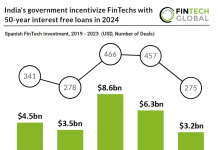Over the past few years, alternative lending has seen its position in the lending market grow considerably as needs and requirements change. In a recent post by cross-border payments firm Currencycloud, the company outlined why it believes alternative lending is not a passing trend.
The company recently spoke to SellersFunding CEO Ricardo Pero, Treyd COO Peter Beckman and commercial director of Growth Lending Jack Trowbridge, who shared their thoughts on the topic of alternative lending.
One of the key reasons why alternative lending is continuing to take considerable market share is due to the fact that working capital and short-term capital loans have played an increasingly important role for SMEs when they want to access funds to support their growth plans, Currencycloud claims.
Alternative lending has benefitted considerably from the fact that many SMEs have been needing more support post-pandemic. Many SMEs who were unable to receive government loans struggled during the pandemic, and a result benefitted from alternative lending.
Trowbridge remarked, “During the pandemic SMEs got through the woods, and are now eager to grow. The working capital model is really important right now for this reason – they need the money to move forward.”
Beckman added, “Traditional bank lending is based on security, which is built on fixed assets. They have a very safe, vanilla point of view. In contrast, the new economy is not based on fixed assets: ecommerce brands don’t own factories, SaaS providers don’t own buildings, or make their own products. It’s why we are seeing different types of balance sheets now.“
Pero, meanwhile, highlighted that as local banks in the US won’t lend to a foreign businesses, this can make global growth plans difficult for SMEs.
According to Currencycloud, there has been a stigma around credit since the 2008 global financial crash. Many alternate lenders looked after SMEs during the pandemic – providing credit at the point of need – and helped reverse the stigma around credit by letting the SMEs feel comfortable about why they are using it – mostly to promote their growth.
Trowbridge remarked that while ‘debt’ is often seen as something you get when ‘the ship is sinking’, tis something which SMEs should get when building the ship.
Most of the innovation in lending, Currencycloud stresses, is being driven by alternative lenders. Many of these lenders are start-ups themselves, and are aware of the challenges business owners face when trying to grow their companies.
Beckman pointed to three examples of FinTech innovations that are vital to what is happening in alternative finance, “First, the immediate value that Fintechs create, the offer is just there and easily accessible to borrowers. Secondly, Fintechs create niche products that are scalable and automated so they become excellent at a particular type of business. Thirdly, APIs are letting businesses integrate their services how they want to, at speed.”
The gold of the 21st century is providing to be data – and this is no different in lending. Currencycloud underlined that access to data is critical for the ability for alternative lenders to offer loans to startups and ecommerce firms who have no physical footprints or assets like buildings.
Pero said, “It’s easy to see why data analytics comes into play with ecommerce: it accelerated in the pandemic and continues to do so. The ability to provide flexible, longer financing terms as being is very attractive to clients.”
Another key trend alongside alternative lending in FinTech is embedded finance. The ability to embed finance, Currencycloud claims, and access a range of markets is a ‘FinTech superpower’. The company added that embedded finance lets alternative lenders find niches that banks can’t see, allowing them to support firms previously turned away by banks.
On embedded finance, Beckman said ,”It is the ultimate customer interface. What Fintech brings with embedded is an extra layer of trust between the merchant and the consumer, for example Klarna BNPL. This is very important in the global economy.”
Trowbridge added that through embedded finance, a lender can embed straight into a business’ accountancy software which is able to pull down their client information, making onboarding easier and quicker so that firms can grow faster.
Pero commented, “With embedded, customers don’t need to move from one platform to another. They can finance that cost in one place – there’s no need to go to a bank and get approval, it’s all there. It’s a great customer experience.”
Alternative lending is also helping to facilitate export growth. Trowbridge remarks, “It’s hard for SMEs to get bank finance for export funding. The alternative finance space should be acting as the next player down to offer SMEs support for export growth, and funding subsidiaries outside the UK and providing provision to enable selling in a cross-border space. Cross-border financing is the next step in this, Covid has brought everything forward by about 5 years.”
Meanwhile, Pero commented, “We operate on a broad niche, and focus on the customer solution. For example we are focusing on making a mobile solution for our customers where they can have their credit information and see their balances on their phone. We’ve worked with Currencycloud to create this.”
Currencycloud concluded, “Flexibility is the key differentiator between banks and alternative lenders who thrive on being adaptable. Cost versus flexibility is the choice their customers are making, and the direction of travel is pointing in the direction of the alternative lenders.”
Copyright © 2022 FinTech Global











